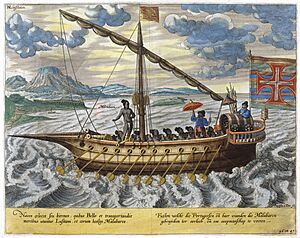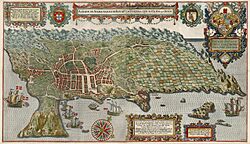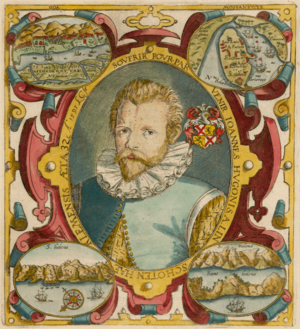Jan Huyghen van Linschoten facts for kids
Jan Huygen van Linschoten (born 1563 – died 1611) was a Dutch explorer, merchant, and writer. He became famous for sharing secret information about trade routes and maps of Asia that the Portuguese had kept hidden for a long time. His work helped other European countries, like the Netherlands and England, to start trading in the East Indies.
Between 1583 and 1588, Jan Huygen lived in Goa, a Portuguese colony in India. There, he worked as a secretary for the Archbishop. During this time, he carefully copied secret maps and gathered important details about sea currents, islands, and safe navigation paths. This information was vital for ships to travel safely.
In 1596, he published a very important book called Itinerario. This book showed detailed maps of voyages to the East Indies, especially India, for the first time in Europe. Because of his book, the Dutch East India Company and the British East India Company were able to challenge Portugal's control over trade with Asia.
Contents
Early Life and Adventures
Jan Huygen was born in 1563 in Haarlem, a town in Holland. His father was an innkeeper. When Jan was young, his family moved to Enkhuizen. He probably went to a Latin school where he learned reading, writing, and math. He loved reading stories about history and exciting adventures.
At 16, in 1579, Jan Huygen left Holland. He wanted to find adventure and have "something to tell [his] children" when he returned home. He first went to Seville, Spain, where his older brothers had a business. He hoped to become a merchant there.
Later, Jan Huygen found a job in Lisbon, Portugal. When trade slowed down, he looked for new opportunities. With help from his brother, he became a secretary for the new Archbishop of Goa, a Portuguese colony. Jan Huygen sailed to Goa in April 1583. His journey took five months, passing by places like Madeira, Guinea, the Cape of Good Hope, Madagascar, and Mozambique.
Life in Goa


While in Goa, Jan Huygen van Linschoten kept a detailed diary. He wrote down everything he saw about the Europeans, Indians, and other Asians living there. He also got access to secret maps and information about trade and Portuguese sea routes in Southeast Asia. He used his skills to copy these maps and draw new ones. Many of these maps had been kept secret by the Portuguese for over a hundred years!
After returning home, he also gathered stories from other travelers. One of his friends, Dirck Gerritsz, had traveled to China and Japan. Jan Huygen wrote down details about trading conditions and sea routes between different countries. All this information later helped the Dutch and English challenge Portugal's control over trade in the East Indies.
In 1587, the Archbishop of Goa, who was Jan's boss, died during a trip to Lisbon. This meant Jan Huygen's job ended. He sailed back towards Lisbon in January 1589.
Adventures in the Azores

During his journey back, Jan Huygen stopped at Saint Helena Island. There, he learned about the spice trade in Malacca from another traveler. His next stop was the Azores islands. He ended up staying there for two years because his ship was wrecked by the English, who were attacking the island. He used this time to map the city of Angra do Heroísmo on Terceira island.
Jan Huygen finally reached Lisbon in January 1592. After six months there, he sailed back to his hometown of Enkhuizen in July 1592.
Arctic Expeditions
In June 1594, Jan Huygen van Linschoten joined an expedition led by the Dutch mapmaker Willem Barentsz. Their goal was to find a new sea route, called the Northeast passage, above Siberia. They hoped this route would lead to Asia. During this trip, the crew saw a polar bear for the first time! They had to turn back because of huge icebergs.
The next year, in 1595, they tried again with a fleet of six ships. They hoped to trade goods with China. They met some native people called Samoyed but had to turn back again because the sea was frozen. Jan Huygen was one of only two crew members who wrote journals about this exciting expedition.
Return to Holland and Famous Books
In 1595, Jan Huygen van Linschoten wrote his first important book, Reys-gheschrift vande navigatien der Portugaloysers in Orienten. This book was full of sailing directions for ships traveling between Portugal and its colonies in Asia, and also between India, China, and Japan.
This book also included one of the first European descriptions of drinking tea in Japan: "Their manner of eating and drinking is: every man hath a table alone... they drink wine of Rice... and after their meat they use a certain drink, which is a pot with hot water, which they drink as hot as ever they may endure... The aforesaid warm water is made with the powder of a certain herb called Chaa, which is much esteemed..."
In the same year, 1595, he got married.
Jan Huygen van Linschoten wrote two other important books. One was Beschryvinghe van de gantsche custe van Guinea... (Description of the Entire Coast of Guinea...), published in 1597. The other was his most famous, Itinerario: Voyage ofte schipvaert van Jan Huygen van Linschoten naer Oost ofte Portugaels Indien, 1579-1592 (Travel account of the voyage of the sailor Jan Huygen van Linschoten to the Portuguese East India), published in 1596. The maps in this book were very detailed and helpful.
The Itinerario was so important that it was quickly translated into English, German, Latin, and French. It continued to be printed and used for many years after Jan Huygen's death in 1611.
Jan Huygen also translated other books and joined the Dutch East India Company (VOC) in 1606. He even gave advice on starting the Dutch West India Company.
His detailed maps and information were key to breaking Portugal's control over trade. He suggested that traders approach the East Indies from south of Sumatra through the Sunda Strait. This route helped avoid Portuguese ships and became the main way the Dutch traveled to Southeast Asia. This led to the Dutch colonizing the lands that are now Indonesia.
Jan Huygen van Linschoten died in Enkhuizen in 1611. He had been the town's Treasurer since 1597.
Legacy and Honors
- The Linschoten Society was founded in 1908. It publishes old Dutch travel stories and descriptions of countries.
- A small planet, 10651 van Linschoten, is named after him.
Editions
- 1598 English translation, John Huighen van Linschoten, His discours of voyages into ye Easte and West Indies: deuided into foure bookes London: John Wolfe.
- 1874–85 English edition, The Voyage of John Huyghen van Linschoten to the East Indies, London: Hakluyt.
See also
- Chronology of European exploration of Asia


